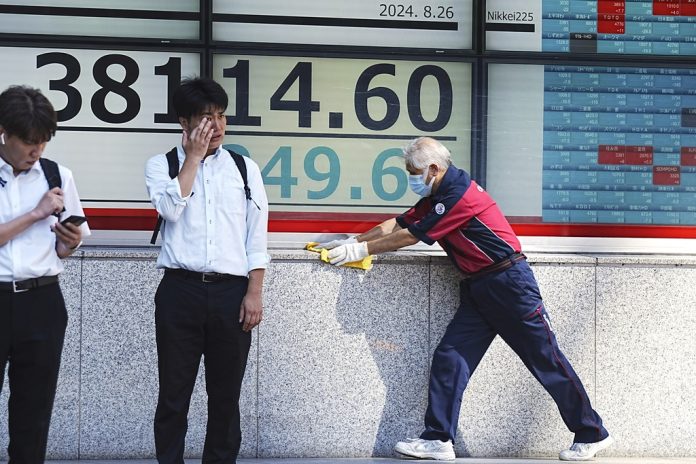HONG KONG (AP) — Asian stocks were mixed Monday after U.S. markets rallied close to their records on the expectation the Federal Reserve will start cutting interest rates soon to help the economy.
U.S. futures edged lower. Oil prices rose after Israel and the Lebanese militant group Hezbollah traded heavy fire on Sunday, triggering potential supply worries.
On Friday, Fed Chair Jerome Powell said the time had come to lower the main interest rate from a two-decade high.
“The time has come for policy to adjust,” Powell said. “The direction of travel is clear, and the timing and pace of rate cuts will depend on incoming data, the evolving outlook, and the balance of risks.”
The stance lifted the yen against the dollar, with the dollar slipping 0.45% to 143.72 yen in Monday trading.
The Bank of Japan’s governor had hinted Friday that more hikes in Japanese interest rates may be coming if inflation stays on course to sustainably hit its 2% target. He also mentioned the bank was closely monitoring recent gyrations in stock prices and currencies.
Japan’s benchmark Nikkei 225 slipped 0.7% and ended at 38,110.22 in response to the stronger yen.
The People’s Bank of China maintained its one-year medium-term lending facility (MLF) rate at 2.30% on Monday, after cutting it by 20 basis points in July. This was delayed from its usual mid-month schedule as part of the central bank’s plan to overhaul its policy rate system and reduce the role of the MLF rate in favor of using short-term rates to guide the markets.
Hong Kong’s Hang Seng index added 1.2% to 17,816.92 while the Shanghai Composite index rose less than 0.1% to 2,855.61.
Australia’s S&P/ASX 200 rose 0.8% to 8,084.50. South Korea’s Kospi closed 0.1% lower at 2,698.01.
On Friday, the S&P 500 rose 1.1% to 5,634.61 after the index pulled within 0.6% of its all-time high set last month and has clawed back virtually all of its losses from a brief but scary summertime swoon.
The Dow Jones Industrial Average rose 1.1% to 41,175.08, crossing the 41,000 level for the first time since it set its own record in July, while the Nasdaq composite jumped 1.5% to 17,877.79.
Powell’s speech marked a sharp turnaround for the Fed after it began hiking rates two years ago as inflation spiraled to its worst levels in generations. The Fed’s goal was to make it so expensive for U.S. companies and households to borrow that it slowed the economy and stifled inflation.
While careful to say the task is not complete, Powell used the past tense to describe many of the conditions that sent inflation soaring after the pandemic, including a job market that “is no longer overheated.” That means the Fed can pay more attention to the other of its twin jobs: to protect an economy that’s slowing but has so far defied many predictions for a recession.
The smaller stocks in the Russell 2000 jumped 3.2% to lead the market. Smaller companies can feel greater benefit from lower interest rates because of their need to borrow to grow.
In the S&P 500 index of big companies, more than 85% of the stocks climbed.
In the bond market, the yield on the 10-year Treasury fell to 3.79% from 3.86% late Thursday. The two-year Treasury yield, which moves more closely with expectations for action by the Fed, dropped to 3.91% from 4.01% late Thursday.
In energy trading, benchmark U.S. crude rose 62 cents to $75.45 a barrel. Brent crude, the international standard, rose 69 cents to $78.84 a barrel.
The euro cost $1.1180, down from $1.1190.
Source: post





